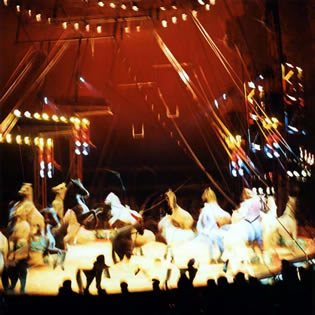Leonardo Pellegatta Il Circo - The Circus
2010.05.07. (fri) - 05.16. (sun)
Open 12:00 - 20:00 Closed on Thursday
Tent is growing up, and Circus is now up in the air... it is like an air baloon.
Year after year, I was able to see new things through the perspective of the big top (Chapiteau): the circus people, their showcase, their backstage work, their continuous journeys, and the bonds inside a small circus family became familiar to me. Sometimes the Circus was transforming itself, becoming as exactly how I think it should be: absolute ideal of fantasy and creative power.
Medrano and Darix Togni are big circuses, well-known in Europe. The Barcellona is a small family structure circus. Spending a long time with the Barcellona circus, I could see how people of this family and the Big Top are entwined so tightly, connected as in symbiosis. The big top seems to me like an extension of the body of the circus people; all the important moments in their life, such as their birthdays and marriages, are celebrated under the Big Top. The Big Top preserves the identity of the circus, and it embodies a magical entity: disclosing an unexpected reality to the children in the audience and revealing to the circus children, their own craft and destiny.
The journey of the circus is, at the same time, an ancestral journey. As Fellini said: “the acrobat, the magician and the lion trainer represent eternal values: force, courage, rigor, physical ability … But the clown is making fun of us questioning the human being about the fragility, incoherence and absurdity of life”. In order to survive the Circus has to continue his journey for ever, without any limits; and not only referring to the caravans’ journey, but referring as well to the “persona” the people of the circus represent: the journey of the circus characters must continue, generation after generation, the oral and physical knowledge has to be transmitted.
Stepping into the small entrance to the circus is, in a way, as if I am stepping into a small door to my childhood, and sometimes the circus seemed to me so surreal as to be facing again an unbearable reality
Leonardo Pellegatta Profile
orn in Milan, Italy in 1970.<br />
Since 1997 he works as a professional photographer especially for theater and dance performance. He has been the official photographer and film-maker for the opera and theater festival "Spoleto Festival of the Two Worlds" for 10 years since 1998.<br />
<dd> </dd>
In 2003, he moves to Tokyo, Japan, collaborating with Japanese and Italian magazines and international graphic & fashion designers. His photos have been appeared among the others by Yomiuri Shimbun (the Anniversary campaign), Shiseido, Malo and the Austrian fashion designer Edwina Horl (Piratery). Now his works has distributed in Japan and in the world through some photo agencies, such as Amana-Images, Ask-Images (French) and Azibul (Italy).
<dd> </dd>
Dec. 2009 - "Requiem”at the gallery Semina Rerum in Zurich, Switzerland.<br />
Jul. 2009 -“Il Circo" at the Gallery Nagune in Tokyo<br />
with the support of the Italian Institute of Culture of Tokyo.<br />
Nov. 2007 - "Indefinite Path" at A+M gallery in Milan, Italy.<br />
Oct. 2000 - "Cityscapes" at the Galleria Soletti in Milan, Italy.<br />
Dec. 2006 - "Indefinite Path" at the Gallery Ef of Tokyo<br />
with the support of the Italian Institute of Culture.<br />
Oct. 2004 - "Visioni-Maboroshi" at the Japan Foundation of Bangkok, Thailand<br />
with the support of Italian Embassy.<br />
Nov. 2003 - "Visioni-Maboroshi" at Gallery Ef in Tokyo, Japan.<br />









